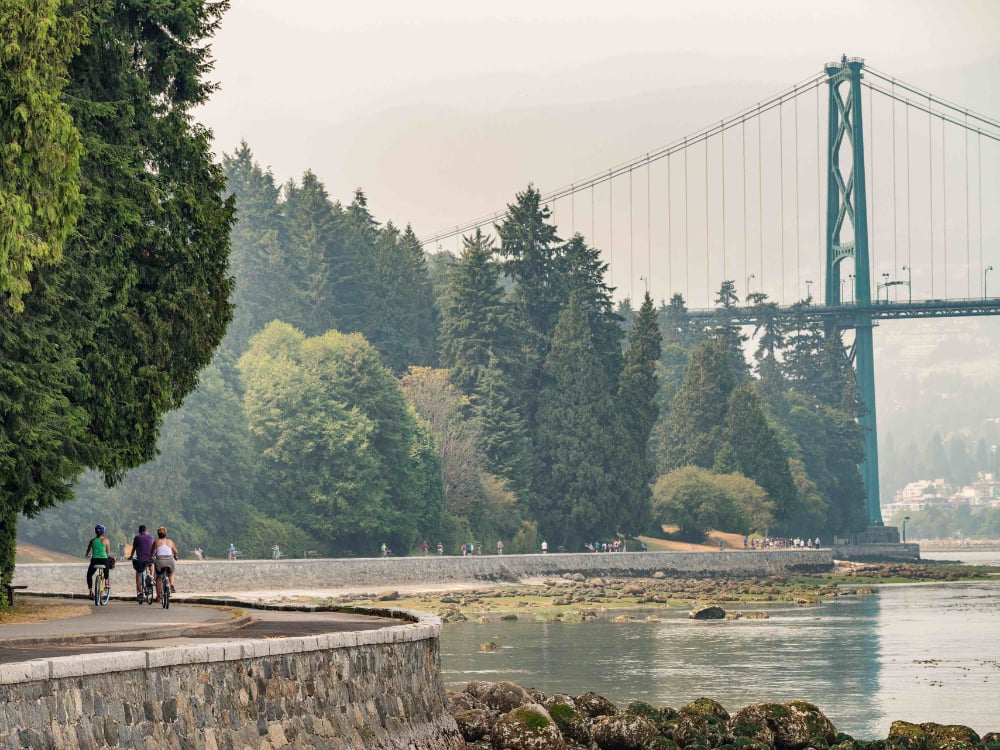Two Sundays ago, I found myself shivering in a muddy field alongside almost 100 other people, bikes in hand, awaiting the start of Love the Lane.
The celebration ride for the Stanley Park Bike Lane was in response to the incoming Vancouver Park Board’s announcement that the lane would be removed for the winter until a new configuration could be implemented the following spring. The park board cited low ridership in the rainy months as rationale for its removal. Meanwhile, cycling advocates argued that slick roads and limited daylight made the protected lane more necessary in the winter. Advocates were also worried that once removed, the lane would not come back.
Around me were people of all ages and abilities clad in a collection of colourful rain gear, from fancy Gore-Tex jackets to thin plastic ponchos. The rain — coming straight down in fat drops — had me questioning why I had left the warm comforts of home that morning. The ride’s organizer, cycling advocate Lucy Maloney, addressed the crowd, quipping that our turnout despite the weather sent a strong message to the park board. After a rousing speech and a chorus of twinkling bike bells, we set off, smiling through the rain as ’80s disco hits blared out of Maloney’s portable speaker.
The Stanley Park Bike Lane is a separated one-way bicycle lane that runs along the length of Park Drive. First introduced in 2020 as part of municipal responses to local residents “looking for ways to stay healthy outdoors during COVID-19,” it has drawn both significant praise and ire.
Love the Lane was not the only organized event regarding the lane this year: earlier in the summer, disability advocates and NPA park board commissioners held a Stanley Park for All rally in opposition of the lane. Ferguson Point Restaurant Inc. and Stanley Park Operations Ltd. — two companies behind popular restaurants in Stanley Park including the Teahouse and the Prospect Point Bar & Grill — even launched a legal challenge against the park board over the lane, citing lost revenues and poor consultation.
Do bike lanes hinder accessibility?
Opponents of the lane bring up accessibility issues, noting that vehicle traffic along Park Drive is often at a standstill on summer weekends. One of their arguments is that cycling infrastructure is inherently ableist and doesn’t consider people who may not be able or comfortable riding a bike.
As we approached the incline leading up to Prospect Point, this argument was on my mind. The rain had turned into sleet and I was having a hard time picturing somebody with mobility issues riding up the hill. And what about families with children? Surely we couldn’t expect a five-year-old to pedal themselves up in bad weather. I posed this question to a fellow rider, Rhi, who shared her experience as a mom without a car. Rhi was riding an e-cargo bike with her two young children seated behind her, keeping their feet warm in carrier bags filled with hot water bottles.
“We don’t own a car, so with the bike lane we were able to access parts of the park that we couldn’t get to on bike before,” she said.
There was also the issue of safety, which was well highlighted by a truck that flew by us going at least double the 30 kilometres-per-hour speed limit.
“I’m a pretty comfortable urban cyclist, but I didn’t really feel comfortable riding up Park Drive with my two kids before the bike lane,” Rhi said. “There were too many drivers going way too fast, looking at the scenery and not paying attention.”
Access for children, families and people carrying heavy loads is an argument made by many for the need for two lanes of car traffic. Yet the number of kids I saw at Love the Lane — either pedalling themselves or being transported on cargo bikes — showed that there are other viable options for families besides a motor vehicle.
In an interview, Lucy Maloney also highlighted accessibility barriers associated with cars that are not often talked about, a major one being cost. Expecting people with disabilities to all arrive by car glosses over the people who don’t own cars, or those who may value the independence that adaptable cycling options and transit provide.
Data from the park board’s preliminary Stanley Park mobility study showed that while 80 per cent of people with mobility issues visited by car, 20 per cent accessed the park without motorized transportation, either by walking, rolling or cycling. The data also showed that the majority of people with self-described mobility issues were not alone in their vehicles.
One could argue then that a more equitable solution could be to boost transit options to and within the park. A striking figure from the mobility study was that only one per cent of all trips were made by transit, with poor schedules and a lack of routes highlighted as barriers.
Bikes are good for business
On the chilly Sunday ride in support of the Stanley Park Bike Lane, we arrived at the Prospect Point Bar & Grill, shuttered for the season after only being open for three months this year. Their owner, Ferguson Point Restaurant Inc., has blamed the bike lane for a drop in revenues, in line with a similar sentiments expressed by businesses opposing bike lanes all over the city.
However, many studies point to the opposite. A survey in Toronto showed that business owners vastly overestimated how many of their customers arrive by car and the Vancouver Park Board’s data shows that people who drive alone spend just half of what people who use active transportation do at businesses. People who bike or walk also visit more frequently throughout the year.
Case studies in the U.S. demonstrate that low-car initiatives increase total park visitorship over time, a trend also seen in Stanley Park. Since 1980, total visits have more than doubled, while the proportion of those trips taken by car has decreased by one-third. With 63 per cent of the paved surface in Stanley Park already allocated to cars, a more equitable system would seek to increase the space for other transport modes, which are rapidly on the rise.
More options, more access
We began our descent down the hill with a symphony of brake noise, some riders taking it easy while the more confident of the group adopted aerodynamic racing positions. I hung back, taking time to chat with a rider named Ben, whom I’d been riding with since the start of the day. I asked him about the elephant in the room: couldn’t we just have ridden the seawall, an arguably more scenic and less hilly route?
“I sometimes take the seawall, but only when it’s not crowded,” he said. "When a lot of people are there, I don’t feel safe. There’s so many pedestrians, tourists and I don’t want to be a burden to them.”
It’s important to remember that people cycle in Stanley Park for different reasons: fitness, transportation, escaping the city and connecting with nature. Having more than one cycling option spreads out these needs and can reduce conflicts. The baffles at Prospect Point and Lumberman’s Arch on the cycling side of the seawall are also barriers to those riding cargo bikes, towing child carriers or using hand cycles or other adaptive cycles. As visits to the park via bike increase, the bike lane will help to relieve pressure off an increasingly congested seawall.
We arrived at the bottom of the hill, wiping mud off our faces and trading soggy high-fives. As I spoke to more riders, I realized that we shared the same broad goals as those in the anti-bike lane camp.
After stripping away the Twitter arguments, protest signs and campaign slogans, we see that we’re all just people looking to enjoy the park for what it is: a world-class urban oasis. Protecting our access to it — whichever mode of transport that we choose to use — can sometimes bring up strong feelings and misguided arguments.
It’s important, then, that the park board takes a holistic, data-driven approach to mobility, taking into account the total range of transport options available and the diversity of people who use them. ![]()
Read more: Transportation, Municipal Politics, Environment
















Tyee Commenting Guidelines
Comments that violate guidelines risk being deleted, and violations may result in a temporary or permanent user ban. Maintain the spirit of good conversation to stay in the discussion.
*Please note The Tyee is not a forum for spreading misinformation about COVID-19, denying its existence or minimizing its risk to public health.
Do:
Do not: